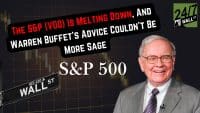 The S&P 500 may be stuck. We’d call it a technical no-man’s land on a longer-term basis. Rather than using the S&P 500 Index, we look at the trading in the SPDRs (NYSE: SPY) as the S&P ETF of choice. This is an unusual situation where you can basically throw the charts out the window when it comes to finding longer-term trading directions. Shorter-term is a different situation, but we do not generally try to follow the minute-by-minute trend of each tick in the market.
The S&P 500 may be stuck. We’d call it a technical no-man’s land on a longer-term basis. Rather than using the S&P 500 Index, we look at the trading in the SPDRs (NYSE: SPY) as the S&P ETF of choice. This is an unusual situation where you can basically throw the charts out the window when it comes to finding longer-term trading directions. Shorter-term is a different situation, but we do not generally try to follow the minute-by-minute trend of each tick in the market.
Our technical analysis affiliate, Adam Hewison of INO, has a quick audio-video analysis charting the S&P500 and we’d again default over to the SPDR rather than the index. Quite simply, with well over 100 million shares traded per day, the SPDR is arguably the most liquid stock out there to track the market.
Hewison went as far as calling the S&P 500 as being “perhaps one of the most frustrating markets I think a lot traders have ever seen.” He noted how longer-term signals are pointing down, while short-term signals are pointing up. Hence our technical no-man’s land.
We took a look at the moving averages on our own and have a different benchmark but the same conclusion. In the SPDRs, $108.22 is the 50-day moving average and $110.80 is the 200-day moving average.
Using more extremes, the SPDRs leveled off around $102 at the peak of selling before the Fourth of July and peaked around $121 at the peak of the market in April. If you draw a line right through the middle of the prior pivots of the last three months, that comes in around $112 on the SPDRs. If a new range gets established on the upside or the downside, there are still many new levels to watch each 2% up and down.
Many fundamental investors believe that pure-technicians use guesswork in their numbers. That is arguable on both sides. Throw in the Summer trading with light volume heading into August and you only add more confusion into the mix. Frankly, the market is in a current situation where relying solely on charts offers very little guidance.
We are currently at a point where the crowd is split between those who think we are heading into very slow and dull growth and those who are expecting a double-dip recession. We have our own bit from recent days that shows 15 safety nets and more detail on why the true double-dip recession looks false.
A chart from StockCharts.com illustrates were we are now:

At the time we went to print this, the SPDRs was up 0.25% at $111.11… make a wish.
JON C. OGG
The Average American Has No Idea How Much Money You Can Make Today (Sponsor)
The last few years made people forget how much banks and CD’s can pay. Meanwhile, interest rates have spiked and many can afford to pay you much more, but most are keeping yields low and hoping you won’t notice.
But there is good news. To win qualified customers, some accounts are paying almost 10x the national average! That’s an incredible way to keep your money safe and earn more at the same time. Our top pick for high yield savings accounts includes other benefits as well. You can earn up to 3.80% with a Checking & Savings Account today Sign up and get up to $300 with direct deposit. No account fees. FDIC Insured.
Click here to see how much more you could be earning on your savings today. It takes just a few minutes to open an account to make your money work for you.
Our top pick for high yield savings accounts includes other benefits as well. You can earn up to 4.00% with a Checking & Savings Account from Sofi. Sign up and get up to $300 with direct deposit. No account fees. FDIC Insured.
Thank you for reading! Have some feedback for us?
Contact the 24/7 Wall St. editorial team.





